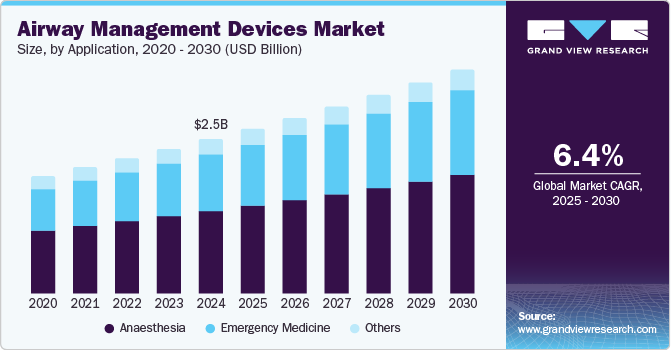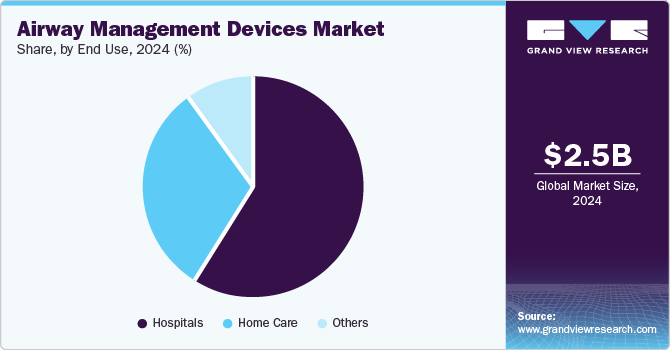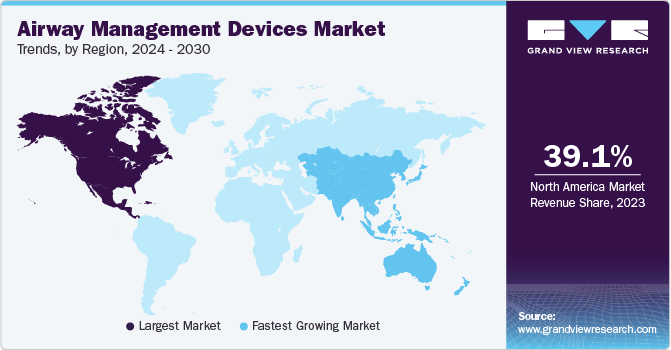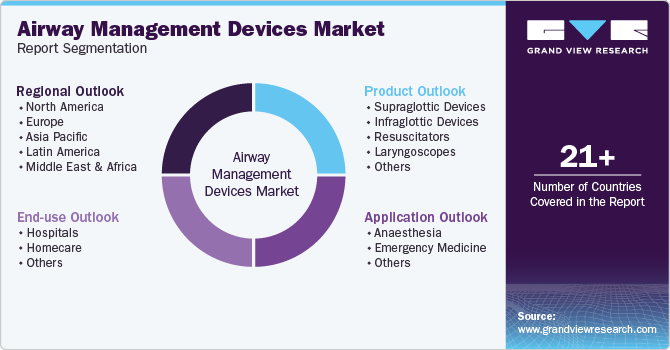- Home
- »
- Medical Devices
- »
-
Airway Management Devices Market Size Report, 2030GVR Report cover
![Airway Management Devices Market Size, Share & Trends Report]()
Airway Management Devices Market Size, Share & Trends Analysis Report By Product (Supraglottic Devices, Infraglottic Devices), By Application (Anesthesia, Emergency Medicine), By End-use, By Region, And Segment Forecasts, 2025 - 2030
- Report ID: GVR-1-68038-776-6
- Number of Report Pages: 90
- Format: PDF, Horizon Databook
- Historical Range: 2018 - 2023
- Forecast Period: 2025 - 2030
- Industry: Healthcare
Airway Management Devices Market Trends
The global airway management devices market size was estimated at USD 2.48 billion in 2024 and is projected to grow at a CAGR of 6.4% from 2025 to 2030. This growth is attributed to the increasing prevalence of respiratory disorders and chronic diseases such as COPD and asthma. In addition, a rise in surgical procedures and preterm births contributes significantly to demand. Furthermore, technological advancements in airway management, including improved devices for pediatric care, enhance efficacy and safety during procedures. Moreover, strategic collaborations among key players and favorable reimbursement policies in regions such as North America are expected to bolster Market expansion over the coming years.

Airway management devices are crucial medical instruments designed to ensure and maintain an open airway, facilitating effective ventilation and oxygenation in patients. These devices are vital in various medical scenarios, including emergency care, anesthesia, and critical care, supporting procedures such as intubation and resuscitation. The increasing incidence of respiratory conditions like COPD and asthma has heightened the demand for these devices, which are essential for managing respiratory distress.
Furthermore, the aging population presents a significant market opportunity, as older individuals often require surgical interventions and respiratory support. Technological advancements have led to developing more innovative, user-friendly airway management solutions, integrating smart technologies and improved materials for enhanced safety and efficiency. The growing prevalence of respiratory diseases globally necessitates effective airway management strategies, further driving Market growth.
Moreover, the rise in surgical procedures and the need for anesthesia contribute to the demand for these devices. As healthcare systems evolve, the focus on advanced airway management technologies is expected to expand, addressing the unique challenges healthcare providers face in managing airways effectively. Overall, the convergence of these factors underscores the importance of airway management devices in contemporary healthcare settings and highlights their promising future in improving patient outcomes.
Application Insights
Anesthesia applications led the market and accounted for the largest revenue share of 53.3% in 2024. This growth is attributed to the rising number of surgical procedures requiring anesthetic intervention. As chronic diseases become more prevalent, there is an increasing need for surgeries that necessitate effective airway management to ensure patient safety and optimal outcomes. In addition, technological advancements have led to the development of innovative devices that enhance the efficiency and efficacy of anesthesia delivery.
Emergency medicines are expected to grow at a CAGR of 7.0% over the forecast period, owing to the increasing incidence of respiratory disorders and acute medical conditions that require immediate intervention. In addition, the prevalence of chronic diseases, such as COPD and asthma, has led to a surge in emergency admissions, necessitating reliable airway management solutions. Furthermore, advancements in device technology have improved their usability and effectiveness in critical situations. Moreover, the growing awareness among healthcare providers about the importance of timely airway management in emergency care further supports Market growth, as hospitals and clinics invest in state-of-the-art equipment to address these urgent medical needs effectively.
Product Insights
The supraglottic devices dominated the market and accounted for the largest revenue share of 34.7% in 2024. This growth is attributed to their various advantages, including ease of tracheal placement and enhanced patient safety. These devices, such as laryngeal masks, are increasingly preferred in various clinical settings due to their ability to facilitate ventilation without the need for tracheal intubation. In addition, as surgical procedures rise globally and chronic respiratory conditions become more prevalent, the demand for supraglottic devices continues to expand.
Laryngoscopes are expected to grow at a CAGR of 12.8% over the forecast period, owing to ongoing technological advancements and the increasing complexity of airway management procedures. Innovations such as video laryngoscopes enhance visualization during intubation, making them essential tools for anesthesiologists and emergency clinicians. In addition, the rising incidence of difficult airways in both elective surgeries and emergency situations drives the demand for these devices.
End-use Insights
The hospitals segment led the market and accounted for the largest revenue share in 2024. This growth is attributed to the rising number of surgical procedures and the increasing prevalence of chronic respiratory diseases. Hospitals serve as primary care centers where airway management devices are essential for ventilation, oxygenation, and anesthetic administration during surgeries. Furthermore, technological advancements have led to developing more efficient and user-friendly devices, encouraging healthcare providers to adopt these solutions. Increased government initiatives to improve patient safety and reduce adverse events also contribute to the growing demand for airway management devices in hospital settings.

The Homecare segment is expected to grow at a CAGR of 7.1% over the forecast period. This growth of driven by a rising aging population and a growing emphasis on providing healthcare services in home settings. Patients with chronic respiratory conditions often require continuous monitoring and support, making Homecare solutions increasingly vital. The convenience and comfort of receiving care at home, combined with advancements in portable airway management technologies, enhance patient compliance and satisfaction. Furthermore, favorable reimbursement policies for home healthcare services encourage families to invest in these devices, thereby boosting Market growth in this sector.
Regional Insights
North America airway management devices market dominated the global Market and accounted for the largest revenue share of 38.9% in 2024. This growth is attributed to the high prevalence of chronic respiratory diseases, such as COPD and asthma, which necessitate advanced airway management solutions. The region benefits from a well-established healthcare infrastructure and significant investments in medical technology, leading to the rapid adoption of innovative devices. Furthermore, favorable reimbursement policies and a strong presence of leading manufacturers further enhance Market growth. The increasing number of surgical procedures and emergency cases also contribute to the rising demand for these devices.

U.S. Airway Management Devices Market Trends
The airway management devices market in the U.S. is expected to grow significantly over the forecast period, owing to a combination of high healthcare expenditure and a growing aging population susceptible to respiratory issues. In addition, the country’s advanced medical facilities are equipped with state-of-the-art airway management technologies, facilitating better patient outcomes. Furthermore, major companies' ongoing research and development initiatives lead to the introduction of novel products, enhancing clinical practices. The emphasis on improving patient safety and reducing procedure complications reinforces the demand for effective airway management solutions.
Asia Pacific Airway Management Devices Market Trends
Asia Pacific airway management devices market is expected to grow at a CAGR of 8.1% over the forecast period. This growth is attributed to rapid economic growth and increasing healthcare spending. In addition, the rising prevalence of respiratory disorders, particularly in countries like China and India, creates a substantial demand for these devices. Government initiatives aimed at improving healthcare access and quality further stimulate Market expansion. Furthermore, the emergence of local manufacturers and strategic partnerships among key players enhance product availability and affordability in this diverse region.
The airway management devices market in China is experiencing notable growth due to its large population and high incidence of chronic respiratory diseases, particularly COPD. The government’s focus on healthcare reform and investment in medical technology has led to increased production and adoption of advanced airway management solutions. Moreover, the outsourcing of manufacturing to China has made these devices more accessible and cost-effective. This combination of factors positions China as a key player in the global airway management devices Market.
Europe Airway Management Devices Market Trends
Europe airway management devices market is expected to grow significantly over the forecast period, fueled by an aging population that requires more medical interventions related to respiratory health. The country’s robust healthcare system emphasizes research and development, leading to continuous innovation in airway management technologies. Furthermore, increasing awareness among healthcare professionals about the importance of effective airway management drives demand for advanced devices. Regulatory support for new product approvals also facilitates Market growth across various European nations.
The growth of the airway management devices market in the UK is expected to be driven by rising healthcare expenditures and an increasing number of surgical procedures requiring effective airway management. In addition, the National Health Service (NHS) prioritizes patient safety and quality care, prompting investments in advanced medical technologies. Furthermore, growing awareness about respiratory diseases among clinicians has led to higher adoption rates of innovative airway management solutions. Collaborative efforts between public health organizations and private manufacturers also enhance product availability in the UK healthcare system.
Key Airway Management Devices Company Insights
Some of the key players operating in the Market include Medtronic, Teleflex Incorporated, Ambu A/S, Medline Industries, LP, and BD. These companies adopt various strategies to maintain and increase their Market share, including new product development, partnerships, collaboration and agreements, and acquisitions.
-
Medtronic develops and manufactures a wide range of airway management devices. Their product portfolio includes innovative solutions such as endotracheal tubes, laryngeal masks, and advanced monitoring systems for pediatric and adult patients. The company operates primarily in the anesthesia and critical care segments, focusing on enhancing patient safety and improving clinical outcomes. Their commitment to research and development ensures that they remain at the forefront of technology in airway management.
-
BD offers a variety of airway management devices that cater to both hospital and Homecare settings. Their product line includes tracheostomy tubes, laryngoscopes, and single-use airway management products designed to facilitate safe ventilation and oxygenation. BD operates in the critical care and emergency medicine segments, emphasizing the importance of infection control and ease of use in their designs. The company’s focus on innovation and quality positions it as a key contributor to advancements in airway management solutions.
Key Airway Management Devices Companies:
The following are the leading companies in the airway management devices market. These companies collectively hold the largest market share and dictate industry trends.
- Medtronic
- Teleflex Incorporated
- Ambu A/S
- Intersurgical Ltd
- BD
- Medline Industries, LP
- Armstrong Medical Ltd
- ICU Medical (Smiths Medical, Inc.)
- Mercury Medical
- Convatec Inc.
- Verathon
Recent Developments
-
In September 2023, Verathon unveiled the GlideScope Go 2, an advanced handheld video laryngoscope designed to enhance airway management in urgent and critical care situations. This next-generation device features QuickConnect technology for seamless operation, allowing clinicians to focus more on patient care. The GlideScope Go 2 is now available in the U.S., reinforcing Verathon's commitment to providing innovative airway management devices that support first-pass success in challenging medical environments.
-
In June 2023, Teleflex Incorporated partnered with Shenzhen Insighters Medical Technology Co., Ltd. to become the exclusive U.S. distributor of the Insighters® Video Laryngoscope system. This advanced airway management device facilitates endotracheal intubation and inspects the upper glottic airway. The system features interchangeable components, allowing real-time high-resolution video sharing and enhancing clinical practice. This addition to Teleflex’s portfolio supports the American Society of Anesthesiologists Difficult Airway Algorithm, improving patient safety in challenging intubation scenarios.
Airway Management Devices Market Report Scope
Report Attribute
Details
Market size value in 2025
USD 2.64 billion
Revenue forecast in 2030
USD 3.59 billion
Growth rate
CAGR of 6.4% from 2025 to 2030
Base year for estimation
2024
Historical data
2018 - 2023
Forecast period
2025 - 2030
Quantitative units
Revenue in USD Million and CAGR from 2025 to 2030
Report coverage
Revenue forecast, company ranking, competitive landscape, growth factors, and trends
Segments covered
Product, application, end-use, region
Regional scope
North America, Europe, Asia Pacific, Latin America, MEA
Country scope
U.S.; Canada; UK; Germany; France; Italy; Spain; Denmark; Sweden; Norway; Russia; India; China; South Korea; Hong Kong; Australia; Singapore; Brazil; Argentina; Kuwait; Qatar; Saudi Arabia; South Africa; UAE
Key companies profiled
Medtronic; Teleflex Incorporated; Ambu A/S; Intersurgical Ltd; BD; Medline Industries, LP; Armstrong Medical Ltd; ICU Medical (Smiths Medical, Inc.); Mercury Medical; Convatec Inc.; Verathon
Customization scope
Free report customization (equivalent to 8 analyst working days) with purchase. Addition or alteration to country, regional & segment scope.
Pricing and purchase options
Avail customized purchase options to meet your exact research needs. Explore purchase options
Global Airway Management Devices Market Report Segmentation
This report forecasts revenue growth at global, regional, and country levels and analyzes the latest industry trends in each sub-segment from 2018 to 2030. For this study, Grand View Research has segmented the global airway management devices market report based on product, application, end-use, and region.

-
Product Outlook (Revenue, USD Million, 2018 - 2030)
-
Supraglottic Devices
-
Infraglottic Devices
-
Resuscitators
-
Laryngoscopes
-
Others
-
-
Application Outlook (Revenue, USD Million, 2018 - 2030)
-
Anaesthesia
-
Emergency Medicine
-
Others
-
-
End-use Outlook (Revenue, USD Million, 2018 - 2030)
-
Hospitals
-
Homecare
-
Others
-
-
Regional Outlook (Revenue, USD Million, 2018 - 2030)
-
North America
-
U.S.
-
Canada
-
-
Europe
-
UK
-
Germany
-
France
-
Italy
-
Spain
-
Denmark
-
Sweden
-
Norway
-
Russia
-
-
Asia Pacific
-
India
-
China
-
South Korea
-
Hong Kong
-
Australia
-
Singapore
-
Japan
-
New Zealand
-
Thailand
-
-
Latin America
-
Brazil
-
Argentina
-
-
Middle East and Africa (MEA)
-
Kuwait
-
Qatar
-
Saudi Arabia
-
South Africa
-
UAE
-
-
Frequently Asked Questions About This Report
b. The global airway management devices market size was estimated at USD 2.48 billion in 2024 and is expected to reach USD 2.64 billion in 2025.
b. The global airway management devices market is expected to grow at a compound annual growth rate of 6.4% from 2025 to 2030 to reach USD 3.59 billion by 2030.
b. North America dominated the airway management devices market with a share of 38.9% in 2024. This is attributable to the supportive government initiatives, substantial implementation of practice guidelines and the high prevalence of major respiratory diseases.
b. Some key players operating in the airway management devices market include Medtronic, Teleflex Incorporated, Ambu A/S, ICU Medical (Smiths Medical, Inc.), Medline Industries, LP.
b. Key factors that are driving the airway management devices market growth include increasing prevalence of respiratory diseases, need of emergency treatment for prolonged illnesses, protracted treatments associated with lung diseases, and advent of advanced techniques.
Share this report with your colleague or friend.
![gvr icn]()
NEED A CUSTOM REPORT?
We can customize every report - free of charge - including purchasing stand-alone sections or country-level reports, as well as offer affordable discounts for start-ups & universities. Contact us now
![Certified Icon]()
We are GDPR and CCPA compliant! Your transaction & personal information is safe and secure. For more details, please read our privacy policy.
We are committed towards customer satisfaction, and quality service.
"The quality of research they have done for us has been excellent."





